
Dave & Les Jacobs/Blend Images/Getty Images
Kefir grains are the starter culture used to ferment fresh milk and create a sweet or sour kefir. When kefir grains are used to ferment milk, the process is similar to making yogurt. Kefir, or fermented milk, contains more probiotic cultures than yogurt, according to the KefirOnline website. It is possible to ferment fresh milk at home, but you need to be very careful to keep your hands and equipment clean. As you store and reuse the starter culture, its quantity grows just a little.
Pour the kefir culture into the glass container.
Pour the fresh milk into the container until it is about two-thirds full. Cover the jar with a clean lid or cloth.
Leave the milk-kefir culture mixture on the counter for 24 hours. If you leave it out for only 12 hours, it will be thinner and have a sweeter taste. If you leave it out for closer to 48 hours, it will be thicker and taste more sour.
Mix the liquid kefir and milk curds that have formed in the jar with a wooden or plastic spoon.
Place a non-metallic sieve on top of a second jar, and pour the kefir into it, allowing the liquid to seep into the jar.
Place the kefir grains in the sieve into a clean, small jar with a lid. Do not wash the grains. Save them for the next batch of kefir.
Related Articles

Why Does Greek Yogurt Have More Protein ...

How to Clean Palladium Jewelry

How to Separate Curds From Whey

What Happens if You Whip Condensed Milk?
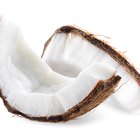
How to Ferment Coconut

How to Make Pickle-Infused Vodka
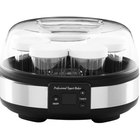
How to Mix Yogurt With Unflavored ...
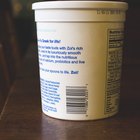
How to Freeze Greek Yogurt

How to Clean White Leather Watches

How to Make a Lip Mask for Extremely ...
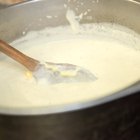
How to Create Sour Milk

How to Store Silver Jewelry So It Won't ...
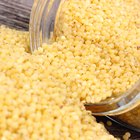
How to Ferment Whole Grains

How to Make Fresh Strawberry Frosting ...

How to Change the Date on a Rolex

How to Freeze Kefir
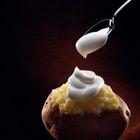
What Is "Cultured Cream"?
How to Mix Baking Soda & Peroxide

How to Remove Roller Ball Ink From ...
How to Ferment Watermelon
References
Tips
- As the kefir is fermenting the fresh milk, a jelly forms around the grains. Called “kefiran,” this jelly helps add to the thickness of the kefir you make.
- Ensure that everything you use to make kefir is very clean before you start a new batch.
- A jar with a lid and rubber gasket is ideal for storing kefir.
- Temperature impacts the speed at which kefir ferments. In warmer places , kefir ferments more quickly.
- The kefir grain is made up of different kinds of bacteria and yeasts that take the shape of cauliflower. The grains are held together with fats, proteins and sugars. All of these products in the kefir grain work together to ferment milk. The bacteria in kefir grain are live probiotic cultures.
Writer Bio
Genevieve Van Wyden began writing in 2007. She has written for “Tu Revista Latina” and owns three blogs. She has worked as a CPS social worker, gaining experience in the mental-health system. Van Wyden earned her Bachelor of Arts in journalism from New Mexico State University in 2006.
Photo Credits
Dave & Les Jacobs/Blend Images/Getty Images